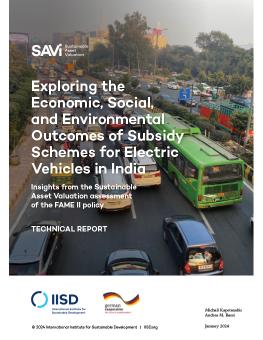
A Sustainable Asset Valuation of the FAME II policy in India
This Sustainable Asset Valuation (SAVi) analyzes the second phase of the Faster Adoption and Manufacturing of Electric (& Hybrid) Vehicles (FAME II) policy in India and demonstrates the economic, social, and environmental benefits and costs under different scenarios.
Cities in India face a variety of urban mobility and transport challenges, including long commuting times, safety concerns, air pollution, carbon dioxide emissions, and others. Simultaneously, the global automotive industry is facing an overhaul due to innovations in digitalization and automation. The electrification of transport vehicles is of particular importance, creating the potential to have a considerable impact in reducing vehicle pollution and greenhouse gas emissions, especially in the country's large metropolises.
To address some of these transport challenges, the Indian National Automotive Board (NAB) developed a funding scheme for electric vehicles (EVs) in order to create demand for those technologies. The second phase (II) of the scheme, titled Faster Adoption and Manufacturing of Electric (& Hybrid) Vehicles in India (FAME II India), aims to support the electrification of public and shared transportation and is implemented via the use of subsidies provided directly by the National Government of India to urban authorities in Indian cities over a 5-year period. The total budget of FAME II is INR 100 billion INR (USD 1.2 billion).
This SAVi assessment uses a variety of models to estimate not only the investment costs (i.e., capital and operation and maintenance costs) but also the added environmental, social, and economic benefits and avoided costs of the FAME II policy in India, under different scenarios. The scenarios focus on how much of the total budget of the subsidy is allocated by the government for the promotion of electric vehicles (EVs) (subsidy) and what is the share of the cost of an EV that will be covered by the government subsidy and by the consumer (contribution).
The results show that the FAME II policy will stimulate economic growth and deliver considerable social and environmental benefits, such as avoided costs of internal combustion engine vehicles and fuel use, avoided costs of air pollution and carbon dioxide emissions, and employment creation. In addition, the analysis shows how important is to find the right balance between reducing the government's subsidy contribution in order for a higher number of EVs to be subsidized and providing the right incentives for households and the private sector to buy EVs.
Participating experts
You might also be interested in
A Sustainable Asset Valuation of a Net-Zero Transport Strategy in Indonesia
This report presents the economic valuation of net-zero transport strategies in Indonesia—their investment costs, added benefits, and avoided costs—encompassing interventions such as investments in public transport, private vehicle electrification, teleworking, and decarbonization of the electricity supply.
Sustainability Assessment of an Onshore Wind Portfolio in Germany
The assessment integrates environmental, social, and economic costs and benefits into an asset valuation to improve the transparency of the wind asset's impacts on the environment and important stakeholders. It also evaluates the asset's financial resilience to climate change risks.
A Sustainable Asset Valuation of Non-Motorized Transport in Coimbatore, India
A Sustainable Asset Valuation (SAVi) of the economic, social, and environmental benefits of a non-motorized transport (NMT) network in Coimbatore, India.
A Sustainable Asset Valuation of a Road Infrastructure Project in Queensland, Australia
This report describes how road authorities can expand traditional cost-benefit analysis for road betterment projects.